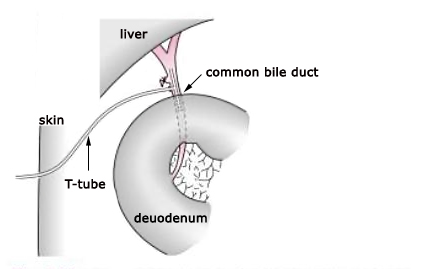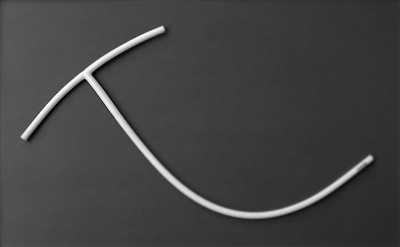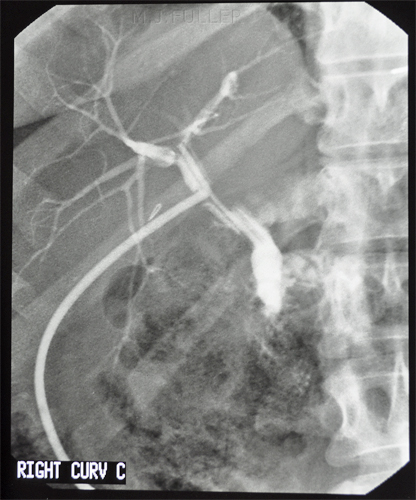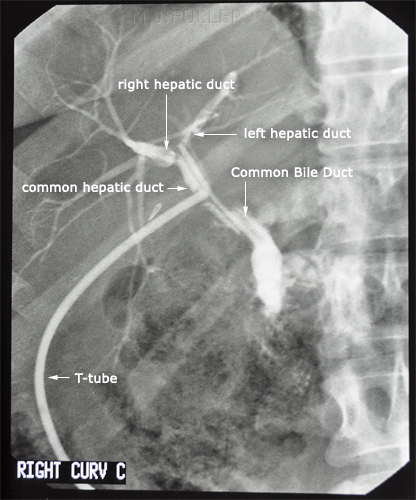T-tube Cholangiogram
Jump to navigation
Jump to search
Introduction
Indications
Contraindications
Preparation
Procedure
Technique Notes
Post Procedure Care
Complications
...back to the Wikiradiography home page
...back to the Applied Radiography home page
Introduction
A T-tube cholangiogram is a fluoroscopic procedure in which contrast medium is injected through a T-tube into the patient's biliary tree. The T-tube is most commonly inserted during a cholecystectomy operation when there is a possibility of residual gall stones within the biliary tree.
Indications
- Patient must have T-tube insitu
- patient's with possibility of residual small gallstones post cholecystectomy
- obstructive jaundice
- bile duct stricture
- surgeon unable to explore bile duct during cholecystectomy surgery
Contraindications
- non-consent by patient to procedure
- contrast or iodine allergy
- pregnancy (? pregnancy test required)
- barium study within last 3 days
Preparation
- patient identification (3 Cs- correct patient, correct side, correct procedure)
- Patient should be wearing a hospital gown
- consent form
- no diet restrictions (some centres suggest fast from solids for 4 hours prior to procedure)
- collect relevant previous imaging for ease of access prior to procedure
- ? prophylactic dose of broad spectrum antibiotic prior to procedure (immunosupressed patients)
- Some operators prefer the T-tube to be clamped prior to the procedure to allow the bile duct to fill with bile. Air in the bile duct can give a false impression of a gallstone.
Procedure
Forrest et al, 1995 in <a class="external" href="http://books.google.com.au/books?id=3Yz1QlhFEi4C&pg=PA146&lpg=PA146&dq=t+tube+cholangiogram&source=bl&ots=TJQJjS8xGc&sig=H30P_q6h1A3bFJDlvjWKlz8dKTc&hl=en&ei=hvYpSs2oN8-HkQXbp7H9Cg&sa=X&oi=book_result&ct=result&resnum=16" rel="nofollow" target="_blank">Margaret F. Alexander, Josephine N. Fawcett, Phyllis J. Runciman Nursing practice: hospital and home : the adult. 2006, p146</a>
- the patient is positioned supine on the X-ray table
- A slightly RPO position can help to ensure the CBD is not superimposed over the patient's spine.
- a preliminary/scout image of the RUQ should be acquired.
- The tip of the T-tube is cleaned with antiseptic
- the T-tube should be raised and tapped to ensure there are no air bubbles lurking in the tube.
- A butterfly needle should be inserted into the T-tube
- The syringe plunger is withdrawn to remove bile from within the duct. (optional)
- An early filling image should be obtained.
- The entire biliary tree should be imaged during injection of contrast medium.
- Injection should continue until the entire biliary tree is opacified and there is passage of contrast into the deuodenum.
- If the intrahepatic ducts do not fill, the patient can be tilted trendelenburg and further contrast injected into the T-tube.
- The patient may need to lie on their left hand side to fill the left hepatic duct.
- At least 2 views of the entire biliary tree should be recorded by spot film (DSI)
- oblique views are often taken
<a class="external" href="http://www.hughsun.com/Products%27+Picture/Canula%28Catheter%29+&+Tube-L/T-Tube-L.JPG" rel="nofollow" target="_blank">http://www.hughsun.com/Products%27%20Picture/Canula(Catheter)%20&%20Tube-L/T-Tube-L.JPG</a>The T-tube is made of very flexible plastic. The flexibility of the plastic facilitates the percutaneous remove of the T-tube without surgical intervention. T-tubes are usually sized between 10 French (10F) and 16 French (16F). This is an AP/PA supine T-tube cholangiogram image. The biliary tree is outlined with contrast medium. There appears to be extravasation of contrast medium outside the biliary tree and minimal contrast in the deuodenum.
Technique Notes
- Contrast media should be diluted with saline so that small biliary stones are not obscured by an overly dense contrast media
- Preliminary/scout images are important. Failure to take a preliminary/scout image is one of the most frequently made errors by Radiology Registrars performing fluoroscopy procedures
- air-bubbles can often be distinguished from stones by their behaviour- air bubbles tend to float 'up hill' and can change shape and may separate into two smaller bubbles.
- If the examination is marred by air bubbles, the biliary system can be flushed with saline and the study repeated.
- If there is any question of distal obstruction, a delayed drainage image should be obtained
Post Procedure Care
- patient can eat and drink normally
- warn patient to advise of any itching or rash post procedure
- patient should remain in hospital for observation for at least 24 hours post procedure
- If the T-tube is removed at the end of the procedure, the wound should be checked for bile leakage for 24 hours
Complications
- persistent biliary fistula (rare)
- biliary peritonitis
- cholangitis
...back to the Wikiradiography home page
...back to the Applied Radiography home page



